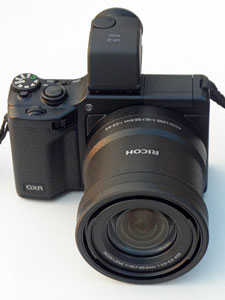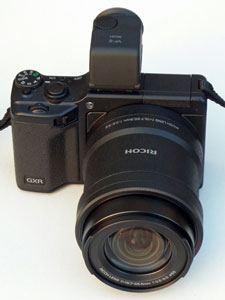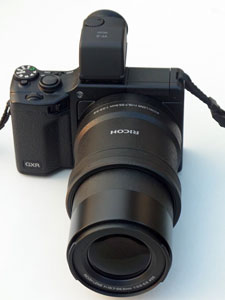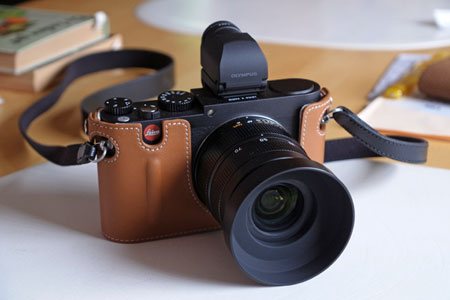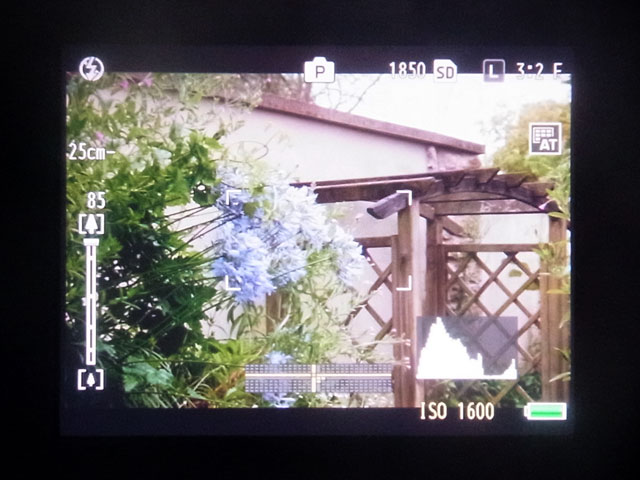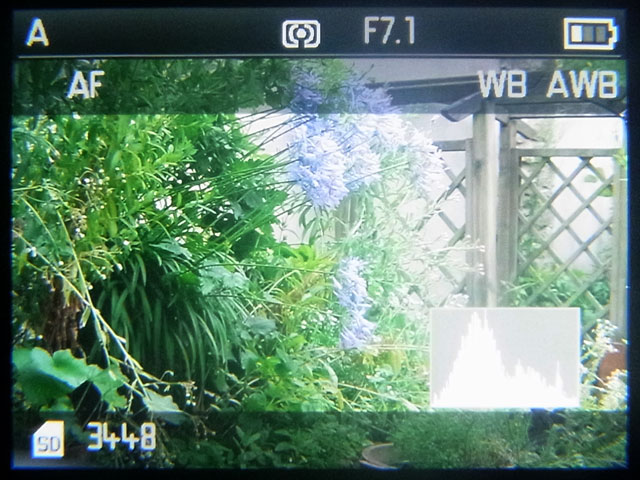Leica X Vario and Ricoh GXR A16: Technical and Functional Comparison
Overall Appearance| Size and Weight | The Lens | Pocketable or Not? | Setting Exposure Modes | Zooming | Electronic Viewfinder | Manual Focus, Screen Magnification, and Focus Assist | Summary and Conclusions: Handling
Archive
On this page, I would like to present a technical and functional comparison between the Leica X Vario (28-70 mm equiv., 16 Megapixels) and the Ricoh GXR A16 (24-85 mm equiv., 16 Megapixels), which are fairly similar cameras. A comparison of the technical data can be found here. Comparison photos can be found here.
Overall Appearance
Both, the Leica X Vario and the Ricoh GXR feature a fixed 3" LCD with 900 K Pixels at the back, and both can be used with an optional, tiltable electronic viewfinder. For me, the viewfinder is "mandatory." I therefore typically show both cameras with the electronic viewfinder attached.
The photos below show typical configurations of the two cameras; since the A16 lens protrudes significantly, I show three states:
Photos: Ricoh GXR body with A16 camera unit attached - "off" (left),"on" (wide; center), "on" (tele; right)
Photo: Leica X Vario in a similar configuration and with protector
When looking at these photos, one immediately sees that the Leica X Vario has a more "symmetric" design, whereas the Ricoh GXR looks asymmetric, making it more difficult to find a place for the left hand (other than supporting the lens). But usually, I also support the Leica lens with my left hand...
Rear View
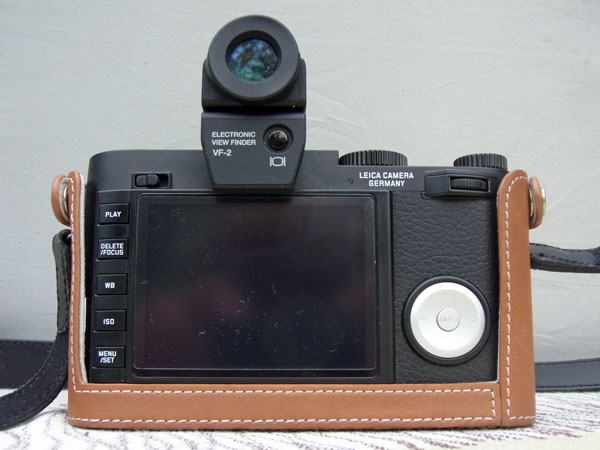
Photo: Rear view of the Leica X Vario (with protector and electronic viewfinder)
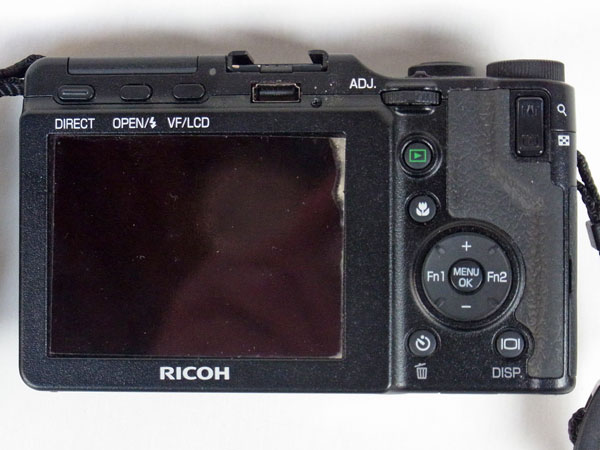
Photo: Rear view of the Ricoh GXR (no viewfinder)
The camera backs differ substantially. Since the Leica X Vario has, because of its more symmetrical design, space enough for buttons to the left of the LCD display, it features a button column similar to that of many DSLR cameras. The right side therefore looks more crammed on the Ricoh GXR body because it has to host all the buttons. Both cameras feature a direction pad but they utilize it quite differently. Note also the zoom lever at the top right of the GXR body - it's not needed on the X Vario. While the GXR uses the button at the center of the direction pad for the confirmation of settings, Leica regrettably chose to change this button into an INFO button and moved the confirmation to the bottom button in the button row at the left side - now requiring two hands for changing and confirming settings...
Admittedly, I make errors with the buttons of both cameras, but I inadvertently hit the Leica buttons more often in error... On the other hand, using manual focus by pressing the "macro" button and turning the up-down dial on the GXR is also nearly impossible for me when using the viewfinder (it may be OK if you use the LCD screen).
The silver look of the direction pad on the X Vario is not only ugly in my mind, it's also misleading: This button is made of plastic - a shame for such an expensive camera! (The GXR direction pad is also made of plastic, but this camera is much cheaper...)
Size and Weight
The Leica X Vario is considerably larger than the GXR with A16 camera unit. Its dimensions are ca. 133 x 73 x 95 mm (W x H x D). When the Ricoh GXR A16 unit is mounted on the GXR body, the dimensions are: 113.9 mm × 74.7 mm × 98.5 mm (W × H × D). Please note that these values do not include the electronic viewfinders.
The Leica X Vario's weight is specified with ca. 650/680 g. However, for a Leica X Vario equipped with a battery, an SD card, the EVF 2, the protector, the lens hood without cap, and the shoulder strap, our kitchen scale measures 760 g for all of this with the Leica shoulder strap and 772 g with the Peak Design shoulder strap (including two anchors). The Ricoh GXR A16 weighs approximately 550 g(battery and SD memory card included). With a should strap, it should still remain below 600g.
The Lens
The lenses of the Leica X Vario and the Ricoh GXR A16 are in some aspects similar, and very different in others. First of all, the technical data are not too different:
- Leica X Vario: Leica Vario-Elmar 18-46 mm f/3.5-6.4 ASPH (corresponds to 28-70 mm in 35 mm format) - 9 lenses in 8 groups, 2 aspherical lenses (one movable lens for focusing)
- Ricoh A16: Focal length 15.7-55.5 mm f/3.5 – f/5.5 (corresponds to 24-85 mm in 35 mm format) - 11 elements in 9 groups (3 aspherical lens elements with 6 surfaces)
The Ricoh lens has an edge regarding the technical data and also uses more elements, that is, it seems to be the more complex construction. On the other hand, the Ricoh lens uses a lot of plastic, whereas the Leica lens seems to be an all-metal construction.
The biggest differences, however, are in the "look" and in the handling of the lenses. The A16 lens has a wider diameter, which is also reflected in its filter diameter of 55mm. When the camera is turned on, the lens extends a little bit when turned on at the wide end (24mm equiv.), and extends more and more towards the long end, reaching at a focal length of 85 mm (equiv.) nearly twice the initial length.
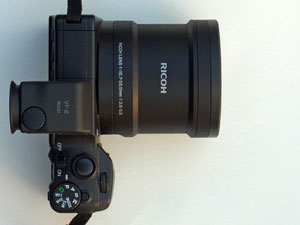 |
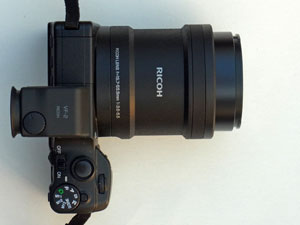 |
Photos: Top view of Ricoh GXR body with A16 24-85 camera unit attached - "off" (about 7cm long; left) and "on" (about 8.7 cm long; right)
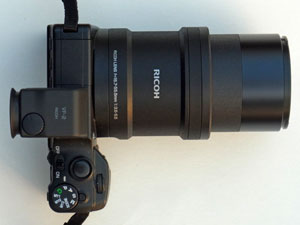 |
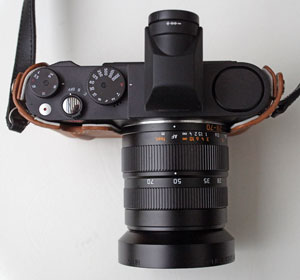 |
Photos: Top view of Ricoh GXR body with A16 24-85 camera unit attached - "on" zoomed to 85mm (about 11.9 cm long; left); Leica X Vario with lens hood attached seen from above at about minimum length (right)
The Leica X Vario lens does not extend when the camera is turned on. It is shortest at a focal length of a little more than 50mm (equiv.), extends nearly a cm when turned to wide angle, and extends a little bit less when turned to tele (not shown). The metal lens hood adds another nearly two "hard" centimeters to the length of the lens.
The following table illustrates how much the lens protrudes (circa values):
| Camera | Off | Wide | Minimum | Tele | Comment |
| Ricoh GXR A16 | 7.0 cm | 8.7 cm | 7.0 cm | 11.7 cm | Minimum at "off" |
| Leica X Vario w/o lens hood | Depends on focal length | 6.9 cm | 6.1 cm | 6.7 cm | Minimum at ca. 50 mm equiv. |
| Leica X Vario with lens hood | Ditto | 8.8 cm | 8.0 cm | 8.6 cm | Ditto |
Another big difference between the two lenses is that the Leica X Vario lens has a focus and a zoom ring (see photos above), while on the Ricoh GXR A16 everything is done using buttons on the camera body (rocker for zooming, macro button plus dial for manual focus).
For more photos of the GXR A16 lens, see here. For the GXR A16 zoom range, see here.
Pocketable or Not?
The Ricoh GXR may be "just" pocketable with an S10 or P10 camera unit, but only without an electronic viewfinder. With an A16 camera unit, the GXR is definitely not pocketable, even when turned off. The same applies to the Leica X Vario because of its protruding zoom lens (and electronic viewfinder if attached), even though it is a member of Leica's "compact" camera series (X series). People who want to put their camera into their trouser or shirt pocket will have to look for alternatives!
 |
 |
Photos: Top view of Ricoh GXR body with A16 24-85 camera unit attached - "off" (about 7cm long; left); Leica X Vario with lens hood attached seen from above at about minimum length (about 8 cm long; right)
Setting Exposure Modes
Setting exposure modes on both cameras is like living in two different worlds. The Ricoh GXR features a "PSAM" mode dial and therefore follows the typical route for digital cameras (some manufacturers use a different notation, and Ricoh changed this for its new GR): You set the basic mode using the dial, and if you do not use program mode, you have to use other dials in order to set aperture, shutter speed, or both.

Figure: Mode dial on the Ricoh GXR body
The Leica X Vario offers a completely different approach to setting exposure modes: There is a dial for setting aperture values and another for setting shutter speeds, both of which also have an "A" (automatic) position. Setting both dials to "A" means program automatic, and so on (see the Figure below for the different modes).
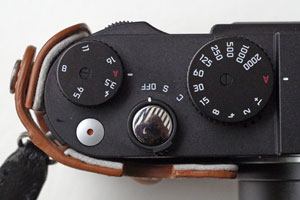 |
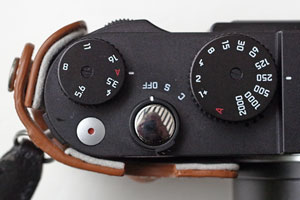 |
|
Automatic program |
Shutter speed priority |
|
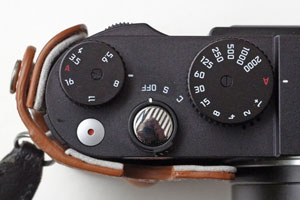 |
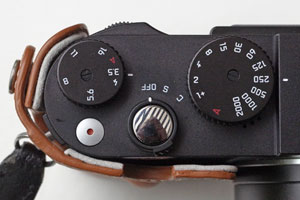 |
|
Aperture priority |
Manual setting |
Figure: Setting the different exposure modes on the Leica X Vario using two dials, one for aperture and another for shutter speed
Personally, I have got used to the "Leica X Vario way." The "Ricoh GXR way" it is easy to understand, but actually a bit more cumbersome when you use modes other than program automatic (P). Anyway, people who mainly use the "P" mode (like me), should not bother at all... But I have to admit that the Leica style encourages me more to experiment with settings because it it easier and faster to do.
Zooming
The Ricoh GXR uses a rocker button for zooming: Pressing the upper button zooms to longer focal lengths (tele), pressing the lower button moves to shorter ones (wide angle). See the figure below:
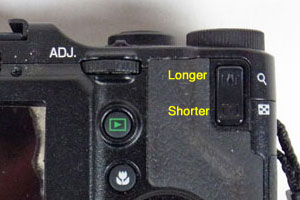
Figure: The zoom rocker buttons on the rear of the Ricoh GXR body
Zooming with buttons is always a tedious affair. You may overshoot, and you may find it too slow as well. Typically, I use "step zoom" on the GXR. This means that pressing the zoom button moves you to the next predefined zoom level, which typically corresponds to "classic" focal lengths of primes. This way, you can shoot at exactly 24 mm, 28 mm, 35 mm, 50mm, 70mm, and 85 mm, which many photographers like (all equivalent focal lengths). The problem with this functionality is that you have to press the button anew for each step. Therefore, it takes quite a while to move from wide angle to tele. I suggested to Ricoh that pressing the zoom button longer should continue zooming - but, of course, no reaction...
Leica X Vario lens has a dedicated zoom ring (the front ring). Although it work by wire, not mechanically, it nearly feels "mechanically" and works much faster than the Ricoh zoom buttons (and the zoom buttons of any other digital camera). Nevertheless, I would have appreciated "clicks" at standard focal lengths (35 mm, 50 mm).
Figure: The zoom ring on the Leica X Vario lens
Conclusions
Changing the focal length with a zoom ring while composing is much faster than having two-directional buttons in action, as is the case with my Ricoh GXR A16. Since I typically use the step zoom functionality there, zooming is even slower because I have to press the zoom lever for each zoom step.
Electronic Viewfinder
Both cameras offer a non-tiltable 3" LCD screen an the camera back with 900 K pixels for interacting with the camera (see the rear views above). Both also allow to attach an electronic viewfinder (EVF) to the flash hot shoe. Since I primarily use my cameras with an EVF, I would like to focus my comparison on this kind of viewfinder.
The Ricoh GXR uses the electronic viewfinder EVF-2 (900 K pixels), which can be attached to the GXR's flash hot shoe. It is tiltable by 90 degrees, and shows 100% of the image field.
You can also attach an electronic viewfinder to the Leica X Vario's flash hot shoe: either the Leica Visoflex EVF 2 or the Olympus VF-2 (at about half the cost). Both seem to be identical, although some users, including me, have spurious issues with the Olympus version, which I bought. These viewfinders have a resolution of 1.4 Megapixels, are tiltable by 90 degrees, and show 100% of the image field.
Photos of the viewfinders can be found at the top of this page. Below, I present photos of the look through the viewfinders of the the Ricoh GXR (this is independent of the camera unit) and the Leica X Vario:
(1) Smaller versions for easier size comparison:
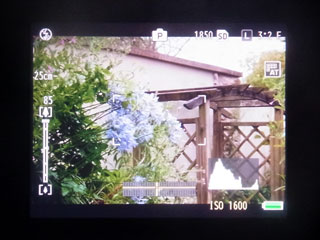 |
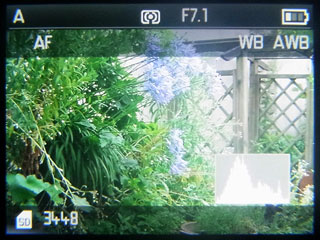 |
|
GXR with EVF2 |
X Vario with VF-2 |
(2) Larger versions for more details (click the images for even larger versions):
Photo: Look through the EVF2 viewfinder on the Ricoh GXR
Photo: Look through the VF-2 viewfinder on the Leica X Vario
The photos were taken with my wife's Ricoh CX4 in macro mode (focus set to infinity). Of course, they do not show the details, for example, the pixels that I can discern in the X Vario's viewfinder.
Conclusions
I find manual focusing using the viewfinder much easier with the Leica X Vario than with the Ricoh GXR even without using any focusing aids, because the viewfinder image is larger and shows more details on the X Vario. However, you can discern the pixels in the X Vario's viewfinder, and the image colors are dull.
The Ricoh's viewfinder image appears brighter to me and I cannot detect any pixels. However, the image is too small for me to focus manually with ease.
Manual Focus, Screen Magnification and Focus Assist
Since manual focusing is a topic, where you can write a lot, I devoted a page of its own to it: Leica X Vario and Ricoh GXR A16: Manual Focus Comparisons. Here, I just present my conclusions on this topic.
Conclusions
Focusing manually with the Leica X Vario is much easier and more joy than with the Ricoh GXR, although the short period of time that the magnified section is displayed is completely insufficient and annoying. The quality of the magnified section is also insufficient. Therefore, I prefer to focus manually on the X Vario without using screen magnification.
Setting the focus manually on the GXR is cumbersome, and the viewfinder resolution is not appropriate for manual focusing. The GXR's screen magnification helps a lot, particularly when the magnified section covers the whole screen, but, of course, you lose the context of the image section. Half-pressing the shutter release button restores the full image and allows you to compose the photo. Both GXR focus peaking modes are not ideal for me. Usually, I therefore do not use focus peaking, only screen magnification (full screen) - whereas others like it a lot (or at least one of the modes - opinions vary in this respect...).
Summary and Conclusions: Handling
All in all, the Leica X Vario's handling style is not only more suitable and "direct" for me, it also inspires me to change and experiment with settings. I typically avoid this when using the Ricoh GXR A16 because I am too lazy to invest the required effort.
| 03.04.2019 |
